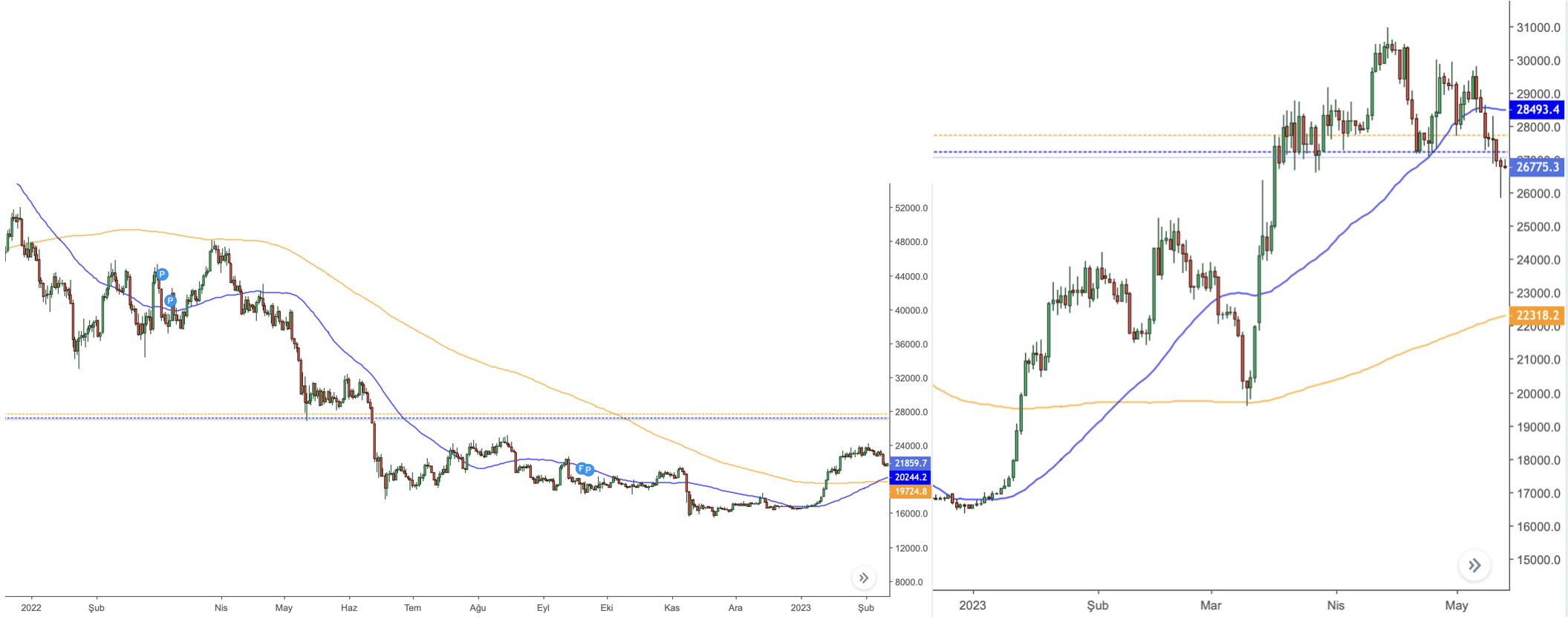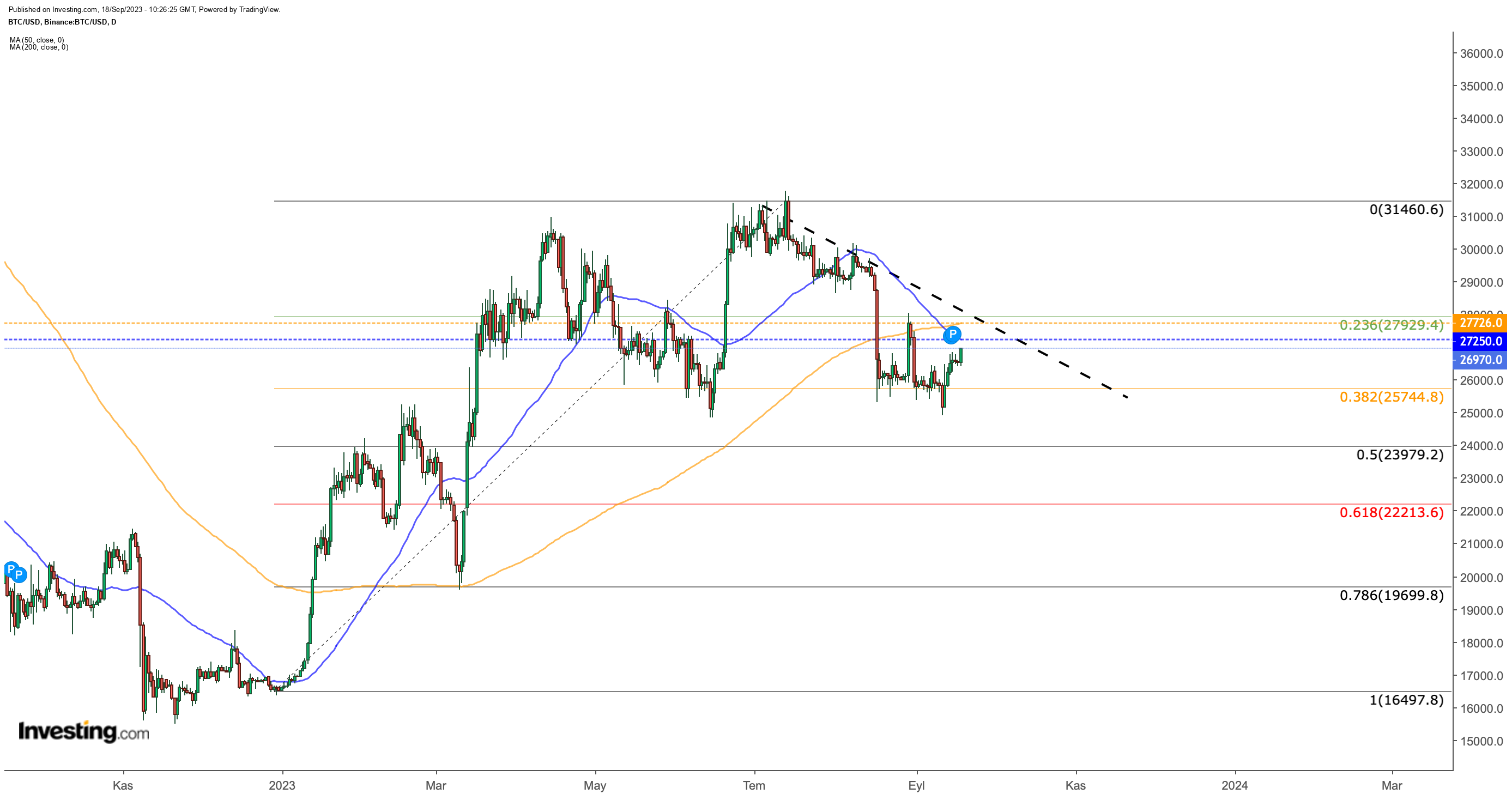Street Calls of the Week
- Bitcoin tests crucial $25,700 support level amidst shifting sentiment
- Fed's Interest Rate Decision could prove a make-or-break moment for the cryptocurrency
- In the following article, I analyze the critical factors to watch for Bitcoin's path in the remainder of the year
Last week, Bitcoin initiated a test of the $25,700 support level. During this time, investor interest remained robust, although there was a perceptible shift in sentiment away from this critical support threshold as the week unfolded.
In the current week, our focus is squarely on the forthcoming interest rate decision from the Federal Reserve. The Bitcoin market has kicked off this pivotal week with a somewhat optimistic tone, notably with the $26,500 mark, which had previously acted as an intermediate resistance point over the past month, now beginning to establish itself as a support level.
The prevailing momentum may propel Bitcoin towards the $27,200 to $27,700 range, which corresponds to the 50 and 200-day moving averages, during the course of this week. This particular zone warrants vigilant observation as it stands as a pivotal juncture influencing Bitcoin's potential new trajectory.
Conversely, it's worth noting that last week witnessed the occurrence of the so-called "Death Cross" in Bitcoin's trading, with the 50-day moving average dropping below the 200-day moving average. Initially, this bearish signal prompted buying activity. Nevertheless, the bearish outlook is expected to persist as long as Bitcoin remains beneath the resistance region around $27,000.

When we examine similar crossovers from the past, a recurring pattern emerges. In the case of the upward crossover witnessed in February (referred to as the Golden Cross), the initial response was bearish. Subsequently, buyers, acting as a protective shield for the 200-day moving average amid market volatility, propelled Bitcoin's ascent from below $20,000 to the $30,000 range.
If we rewind the clock a bit further, we can observe that following the decline in January 2022, coinciding with the last occurrence of the "Death Cross," a similar buying reaction materialized towards the 200-day moving average.
Come March 2022, Bitcoin had managed to recover to the $48,200 level, aligning with the 200-day moving average. However, it proved unable to surpass this threshold and instead entered a persistent downtrend that endured throughout the year. In this phase, following the "Death Cross," Bitcoin underwent a significant devaluation, ultimately registering a 60% decline by year-end.
Turning our gaze to the prospects for 2023, considering the current market's reduced price volatility, there's a possibility that a downward wave in Bitcoin could persist until it reaches the $19,700 level, just below the $20,000 threshold. Remarkably, this level corresponds to the 0.786 Fibonacci retracement level based on the uptrend observed in 2023.
Moreover, while navigating this trajectory, the price range between $22,200 and $25,700 (representing the 0.382 Fibonacci retracement level) may also emerge as a substantial support line, echoing the significance of the 0.618 Fibonacci retracement level.
The evaluation of these current support levels will undoubtedly hinge on the developments unfolding over the next three months.
Furthermore, Bitcoin's ability to conclude the week with closures above the moving average levels around the $27,000 range could potentially nullify the prevailing bearish scenario. In fact, should Bitcoin manage to re-enter the $28,000 territory and establish a firm foothold within this zone, it would signify a breakthrough in the short-term downtrend that emerged following the peak in July. Such a breakthrough has the potential to ignite a surge in momentum, propelling Bitcoin towards the $33,000 to $35,000 range.
In summary, the outcome of Bitcoin's journey into the $27,000 realm this week, coupled with the ensuing trading activity within this zone, will serve as pivotal determinants for the cryptocurrency's new trajectory.
Another crucial factor influencing Bitcoin's movements this week revolves around the Federal Reserve's interest rate decision and Chairman Powell's statements. Analyzing the Fed's previous three interest rate decisions reveals intriguing insights: following a 25 basis point increase in May, the cryptocurrency market exhibited a downward trend until the subsequent meeting. In June, as the Fed maintained interest rates at their current levels, the Bitcoin market responded favorably, driven by its internal dynamics.
Moving to July, the Fed once again raised interest rates by 25 basis points; however, this time, the crypto market remained relatively unfazed by the decision. Given the Fed's predictable stance devoid of surprises, it appears plausible that this week may witness a test of the resistance line reaching towards $28,000, contingent upon the belief that interest rates will remain stable.
Nevertheless, for Bitcoin to firmly establish support at $28,000, it would necessitate further positive developments. This is because even if the Fed opts to leave interest rates untouched, it still retains the option of another rate hike by year-end, accompanied by rhetoric hinting at the potential for extended periods of elevated interest rates. Such a scenario, with associated higher costs, is perceived as a potential deterrent to risk appetite in the markets.
Hence, keen attention is being devoted to the approval status of spot Bitcoin ETF applications, which could potentially inject fresh capital into the Bitcoin market. The green light for such a financial product could significantly boost demand for Bitcoin, irrespective of external market dynamics.
Moreover, the issuance of such a financial instrument prior to the 2024 halving event, expected to reduce Bitcoin's supply, is regarded as a potent catalyst capable of reshaping the cryptocurrency landscape.
